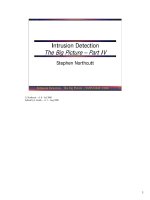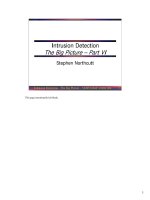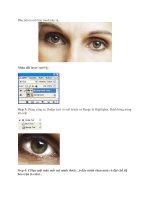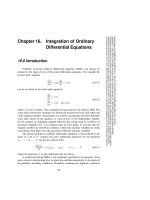Tài liệu Integration of Ordinary Differential Equations part 6 pdf
Bạn đang xem bản rút gọn của tài liệu. Xem và tải ngay bản đầy đủ của tài liệu tại đây (123.79 KB, 3 trang )
732
Chapter 16. Integration of Ordinary Differential Equations
Sample page from NUMERICAL RECIPES IN C: THE ART OF SCIENTIFIC COMPUTING (ISBN 0-521-43108-5)
Copyright (C) 1988-1992 by Cambridge University Press.Programs Copyright (C) 1988-1992 by Numerical Recipes Software.
Permission is granted for internet users to make one paper copy for their own personal use. Further reproduction, or any copying of machine-
readable files (including this one) to any servercomputer, is strictly prohibited. To order Numerical Recipes books,diskettes, or CDROMs
visit website or call 1-800-872-7423 (North America only),or send email to (outside North America).
dy[j]=yest[j];
}
else {
for (k=1;k<iest;k++)
fx[k+1]=x[iest-k]/xest;
for (j=1;j<=nv;j++) { Evaluate next diagonal in tableau.
v=d[j][1];
d[j][1]=yy=c=yest[j];
for (k=2;k<=iest;k++) {
b1=fx[k]*v;
b=b1-c;
if (b) {
b=(c-v)/b;
ddy=c*b;
c=b1*b;
} else Care needed to avoid division by 0.
ddy=v;
if (k != iest) v=d[j][k];
d[j][k]=ddy;
yy += ddy;
}
dy[j]=ddy;
yz[j]=yy;
}
}
free_vector(fx,1,iest);
}
CITED REFERENCES AND FURTHER READING:
Stoer, J., and Bulirsch, R. 1980,
Introduction to Numerical Analysis
(New York: Springer-Verlag),
§
7.2.14. [1]
Gear, C.W. 1971,
Numerical Initial Value Problems in Ordinary Differential Equations
(Englewood
Cliffs, NJ: Prentice-Hall),
§
6.2.
Deuflhard, P. 1983,
Numerische Mathematik
, vol. 41, pp. 399–422. [2]
Deuflhard, P. 1985,
SIAM Review
, vol. 27, pp. 505–535. [3]
16.5 Second-Order Conservative Equations
Usually when you have a system of high-order differential equations to solve it is best
to reformulate them as a system of first-order equations, as discussed in §16.0. There is
a particular class of equations that occurs quite frequently in practice where you can gain
about a factor of two in efficiency by differencing the equations directly. The equations are
second-order systems where the derivative does not appear on the right-hand side:
y
= f (x, y),y(x
0
)=y
0
,y
(x
0
)=z
0
(16.5.1)
As usual, y can denote a vector of values.
Stoermer’s rule, dating back to 1907, has been a popular method for discretizing such
systems. With h = H/m we have
y
1
= y
0
+ h[z
0
+
1
2
hf(x
0
,y
0
)]
y
k+1
− 2y
k
+ y
k−1
= h
2
f (x
0
+ kh, y
k
),k=1,...,m−1
z
m
=(y
m
−y
m−1
)/h +
1
2
hf(x
0
+ H,y
m
)
(16.5.2)
16.5 Second-Order Conservative Equations
733
Sample page from NUMERICAL RECIPES IN C: THE ART OF SCIENTIFIC COMPUTING (ISBN 0-521-43108-5)
Copyright (C) 1988-1992 by Cambridge University Press.Programs Copyright (C) 1988-1992 by Numerical Recipes Software.
Permission is granted for internet users to make one paper copy for their own personal use. Further reproduction, or any copying of machine-
readable files (including this one) to any servercomputer, is strictly prohibited. To order Numerical Recipes books,diskettes, or CDROMs
visit website or call 1-800-872-7423 (North America only),or send email to (outside North America).
Here z
m
is y
(x
0
+ H). Henrici showedhow to rewrite equations (16.5.2) to reduce roundoff
error by using the quantities ∆
k
≡ y
k+1
− y
k
. Start with
∆
0
= h[z
0
+
1
2
hf(x
0
,y
0
)]
y
1
= y
0
+∆
0
(16.5.3)
Then for k =1,...,m −1,set
∆
k
=∆
k−1
+h
2
f(x
0
+kh, y
k
)
y
k+1
= y
k
+∆
k
(16.5.4)
Finally compute the derivative from
z
m
=∆
m−1
/h +
1
2
hf(x
0
+ H,y
m
)(16.5.5)
Gragg again showed that the error series for equations (16.5.3)–(16.5.5) contains only
evenpowers of h, and sothe methodis alogical candidatefor extrapolation `a la Bulirsch-Stoer.
We replace mmid by the following routine stoerm:
#include "nrutil.h"
void stoerm(float y[], float d2y[], int nv, float xs, float htot, int nstep,
float yout[], void (*derivs)(float, float [], float []))
Stoermer’s rule for integrating y
= f(x, y) for a system of n =
nv
/2 equations. On input
y[1..nv]
contains y in its first n elements and y
in its second n elements, all evaluated at
xs
.
d2y[1..nv]
contains the right-hand side function f (also evaluated at
xs
)initsfirstn
elements. Its second n elements are not referenced. Also input is
htot
, the total step to be
taken, and
nstep
, the number of substeps to be used. The output is returned as
yout[1..nv]
,
with the same storage arrangement as
y
.
derivs
is the user-supplied routine that calculates f .
{
int i,n,neqns,nn;
float h,h2,halfh,x,*ytemp;
ytemp=vector(1,nv);
h=htot/nstep; Stepsize this trip.
halfh=0.5*h;
neqns=nv/2; Number of equations.
for (i=1;i<=neqns;i++) { First step.
n=neqns+i;
ytemp[i]=y[i]+(ytemp[n]=h*(y[n]+halfh*d2y[i]));
}
x=xs+h;
(*derivs)(x,ytemp,yout); Use yout for temporary storage of derivatives.
h2=h*h;
for (nn=2;nn<=nstep;nn++) { General step.
for (i=1;i<=neqns;i++)
ytemp[i] += (ytemp[(n=neqns+i)] += h2*yout[i]);
x+=h;
(*derivs)(x,ytemp,yout);
}
for (i=1;i<=neqns;i++) { Last step.
n=neqns+i;
yout[n]=ytemp[n]/h+halfh*yout[i];
yout[i]=ytemp[i];
}
free_vector(ytemp,1,nv);
}
734
Chapter 16. Integration of Ordinary Differential Equations
Sample page from NUMERICAL RECIPES IN C: THE ART OF SCIENTIFIC COMPUTING (ISBN 0-521-43108-5)
Copyright (C) 1988-1992 by Cambridge University Press.Programs Copyright (C) 1988-1992 by Numerical Recipes Software.
Permission is granted for internet users to make one paper copy for their own personal use. Further reproduction, or any copying of machine-
readable files (including this one) to any servercomputer, is strictly prohibited. To order Numerical Recipes books,diskettes, or CDROMs
visit website or call 1-800-872-7423 (North America only),or send email to (outside North America).
Note that for compatibility with bsstep the arrays y and d2y are of length 2n for a
system of n second-order equations. The values of y arestoredinthefirstnelements of y,
while the first derivatives are stored in the second n elements. The right-hand side f is stored
in the first n elements of the array d2y; the second n elements are unused. With this storage
arrangement you can use bsstep simply by replacing the call to mmid with one to stoerm
using the same arguments; just be sure that the argument nv of bsstep is set to 2n.You
should also use the more efficient sequence of stepsizes suggested by Deuflhard:
n =1,2,3,4,5,... (16.5.6)
and set KMAXX =12in bsstep.
CITED REFERENCES AND FURTHER READING:
Deuflhard, P. 1985,
SIAM Review
, vol. 27, pp. 505–535.
16.6 Stiff Sets of Equations
As soon as one deals with more than one first-order differential equation, the
possibility of a stiff set of equations arises. Stiffness occurs in a problem where
there are two or more very different scales of the independent variable on which
the dependent variables are changing. For example, consider the following set
of equations
[1]
:
u
= 998u + 1998v
v
= −999u − 1999v
(16.6.1)
with boundary conditions
u(0) = 1 v(0) = 0 (16.6.2)
By means of the transformation
u =2y−zv=−y+z (16.6.3)
we find the solution
u =2e
−x
−e
−1000x
v = −e
−x
+ e
−1000x
(16.6.4)
If we integrated the system (16.6.1) with any of the methods given so far in this
chapter, the presence of the e
−1000x
term would require a stepsize h 1/1000 for
the method to be stable (the reason for this is explained below). This is so even









